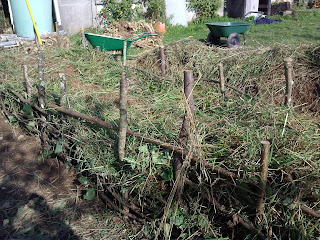Hügelkultur attempts to mimic the process of decomposition of trees in a forest environment. Over time the wood breaks down and becomes almost sponge-like soaking up and retaining water. The area near the bed is nutrient rich has improved soil fertility, better water retention and significantly warmer soil, improving plant growth on or around it. Furthermore it is raised so that those with lower mobility (the parents as they age, especially Mum with her knees!) can more easily access the food growing on it.
So lets take you through the construction process.
Firstly a sunken Hügelkultur bed. Dig out all the nasty box hedge, stand back and admire your work.
Fill the hole with wood of differing sizes.
If you have compost (we do) fill the gaps with some of this lovely worm-created soil.
Add more biomass, in this case off-cuts from the prior destruction of hedgerow.
Cover with some soil that was excavated from the hole.
Top dress with grass to act as a mulch, keep adding this over the winter period to build more biomass.
Alternative to the above, you can create the bed on top of the surface.
The same steps as above, wood, compost and other biomass.
As it's above ground perhaps some stakes...
... and jauntily weaved hazel sticks.
Again lasagna the layers.
More weaving to hold all the stuff together.
Finalise with grass.
Both beds should be good to receive some plants in the spring and for the foreseeable future. Self-fertile, good aeration and good moisture retention. Have a go, share your results, satisfy permaculture principal, Care of People!


































